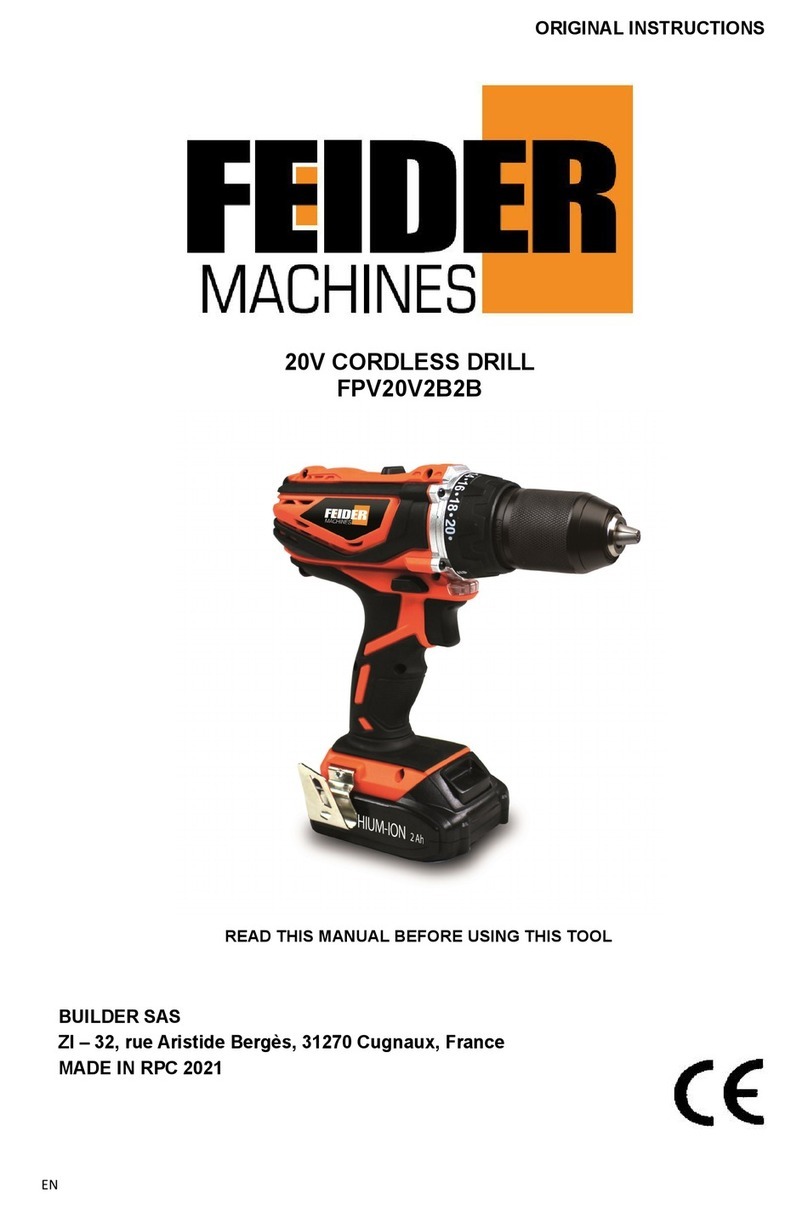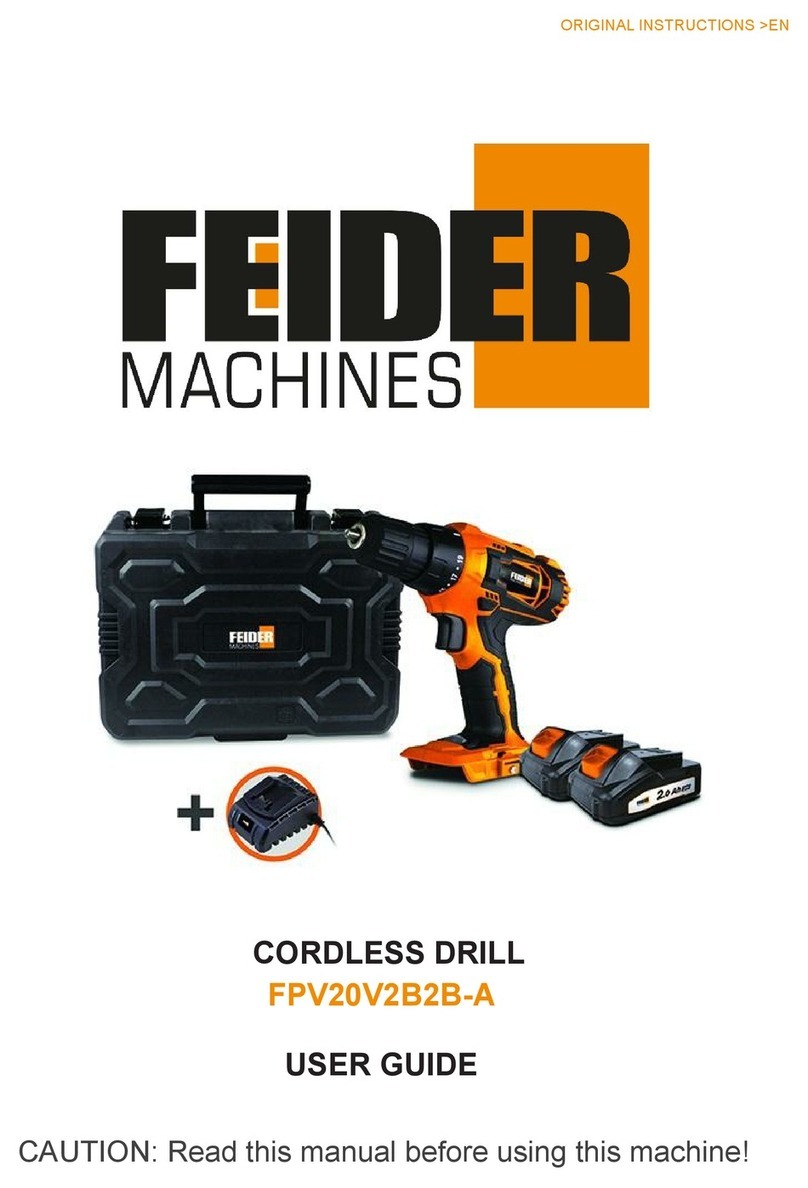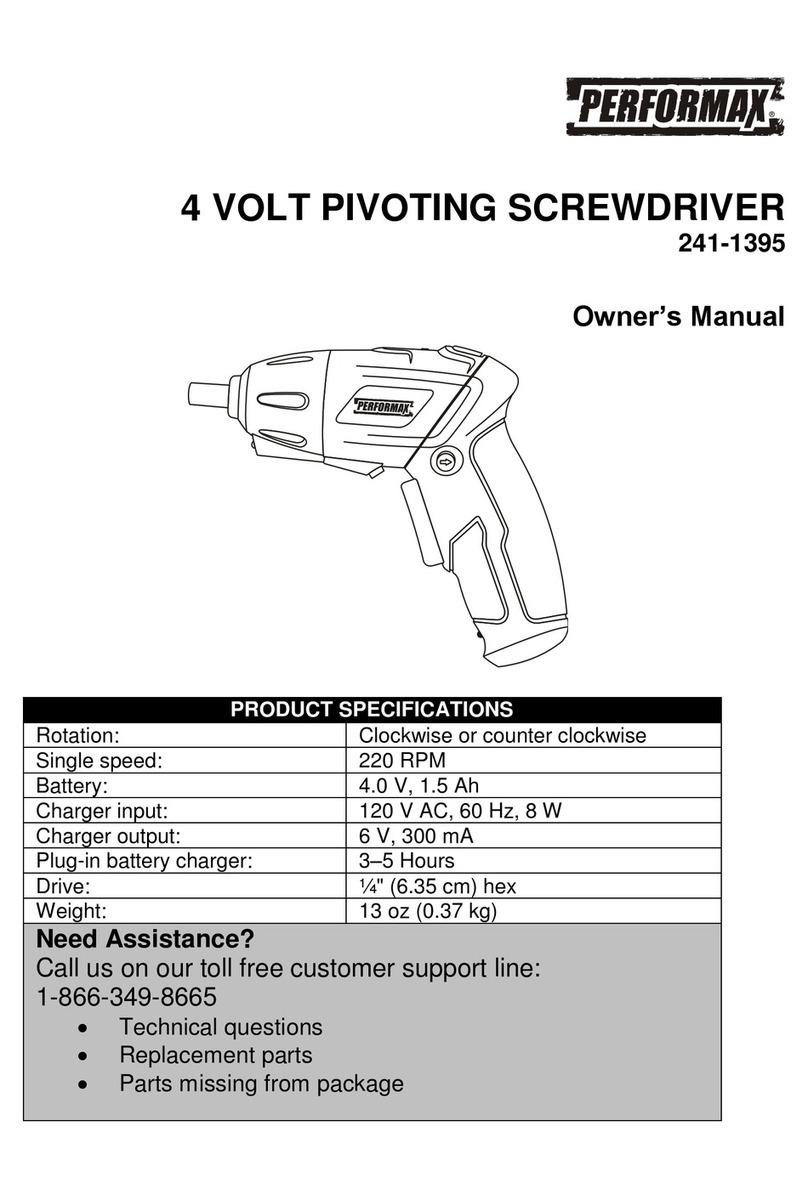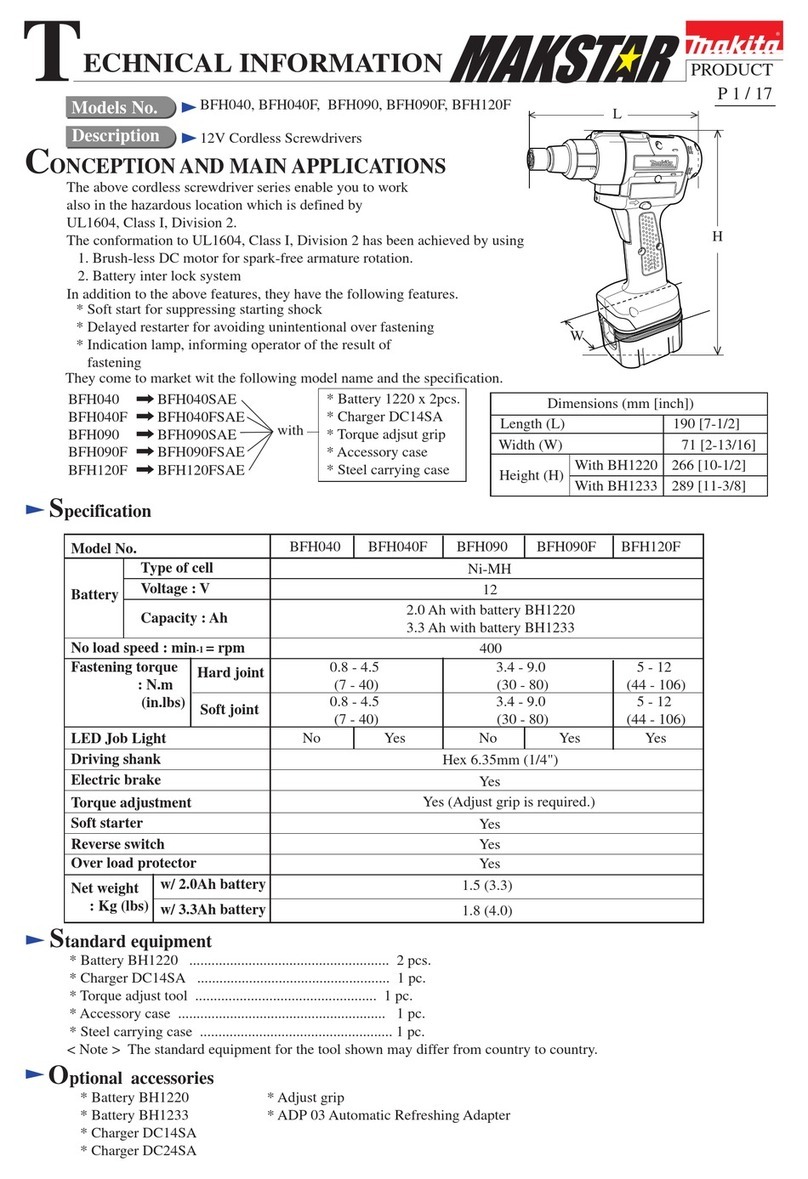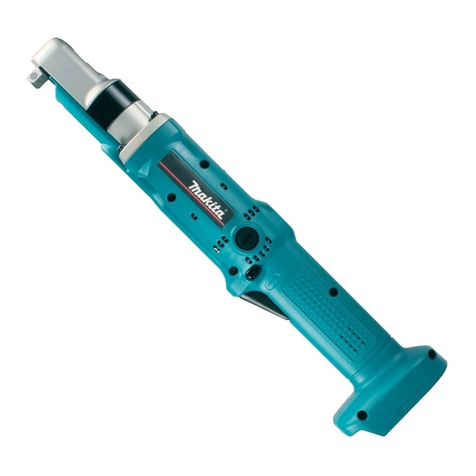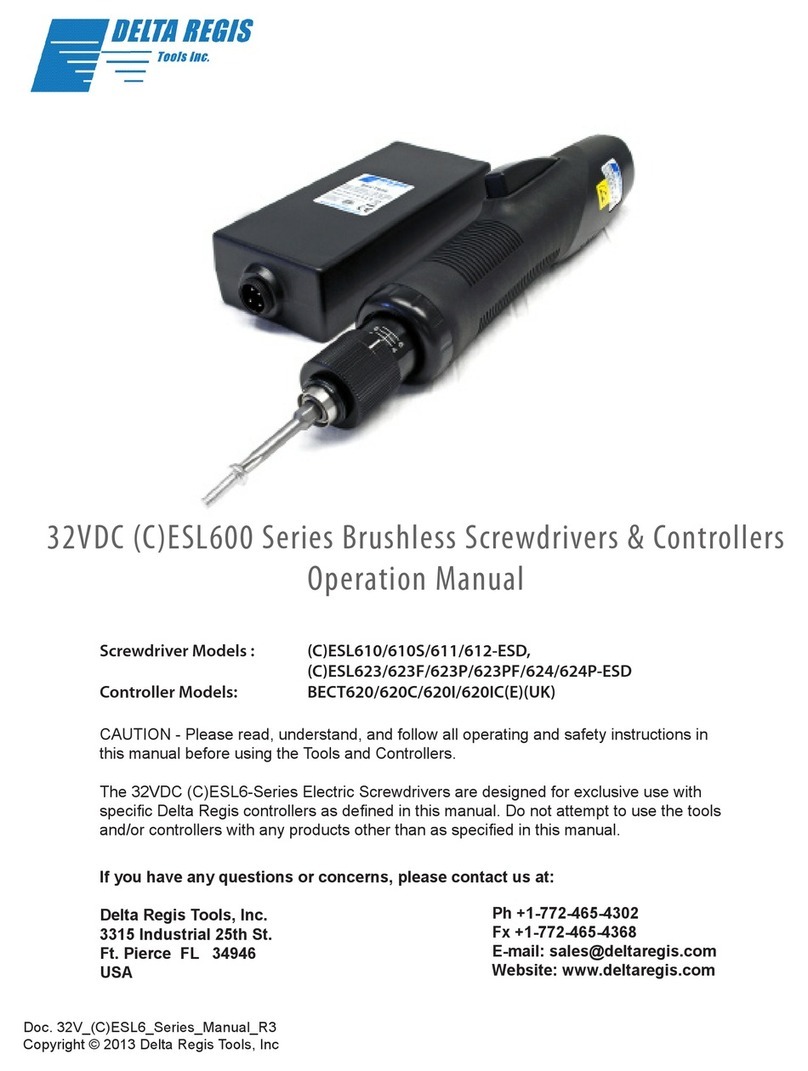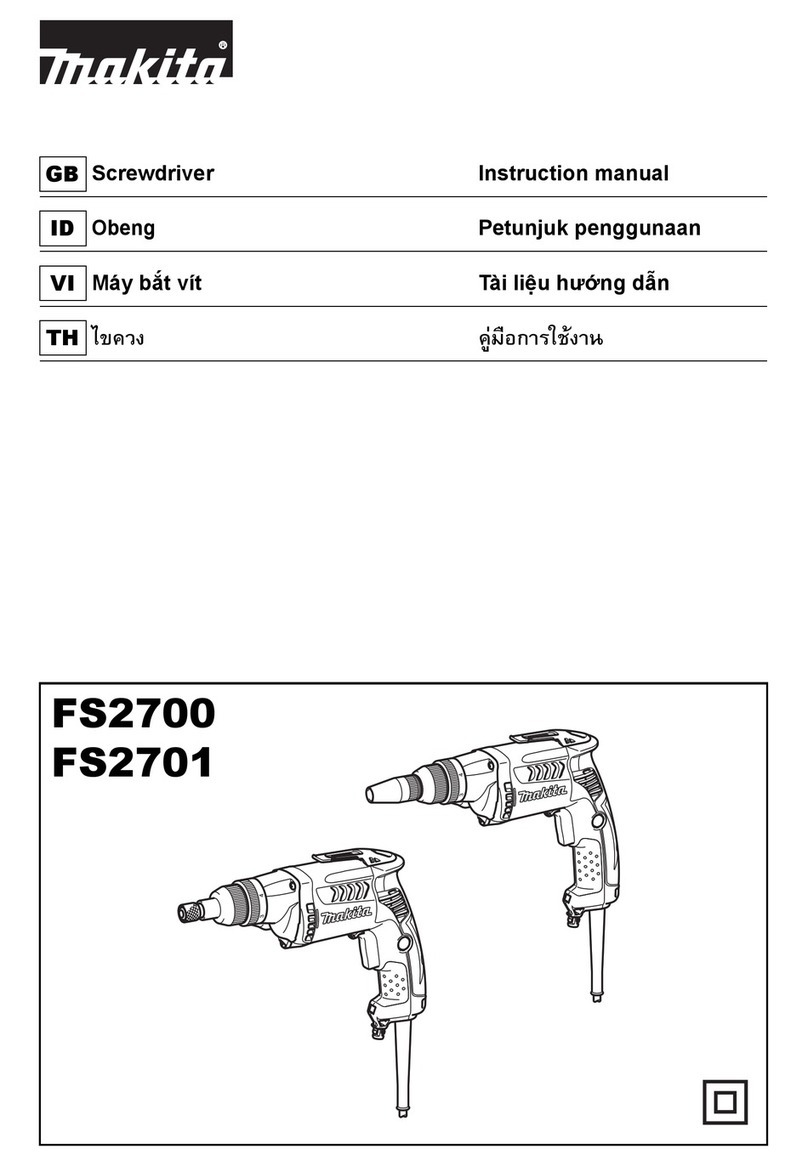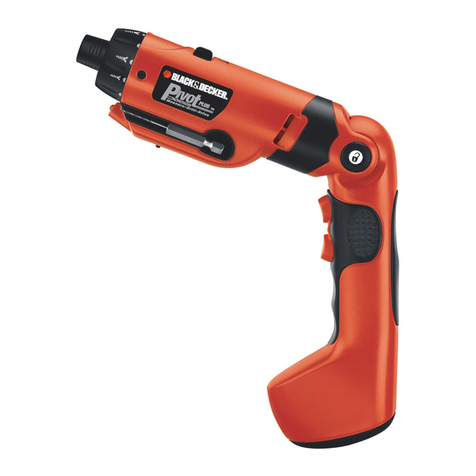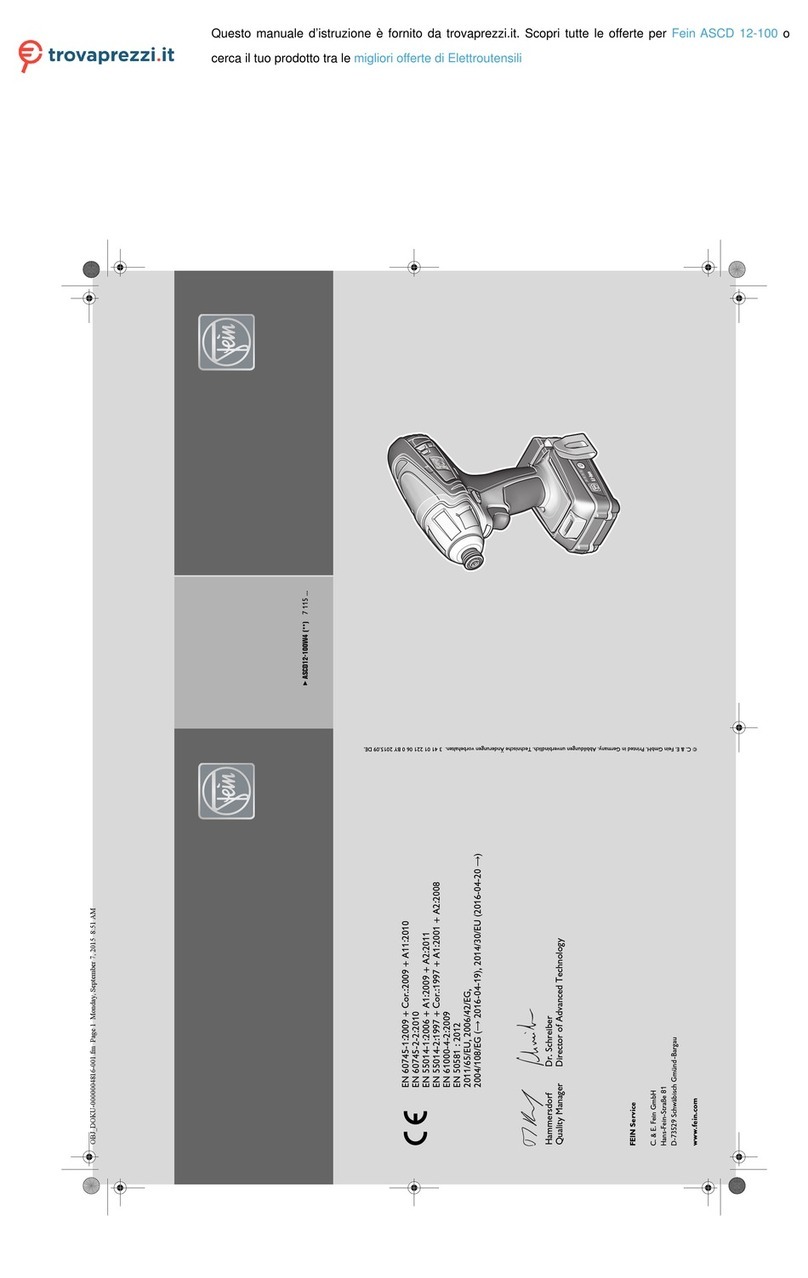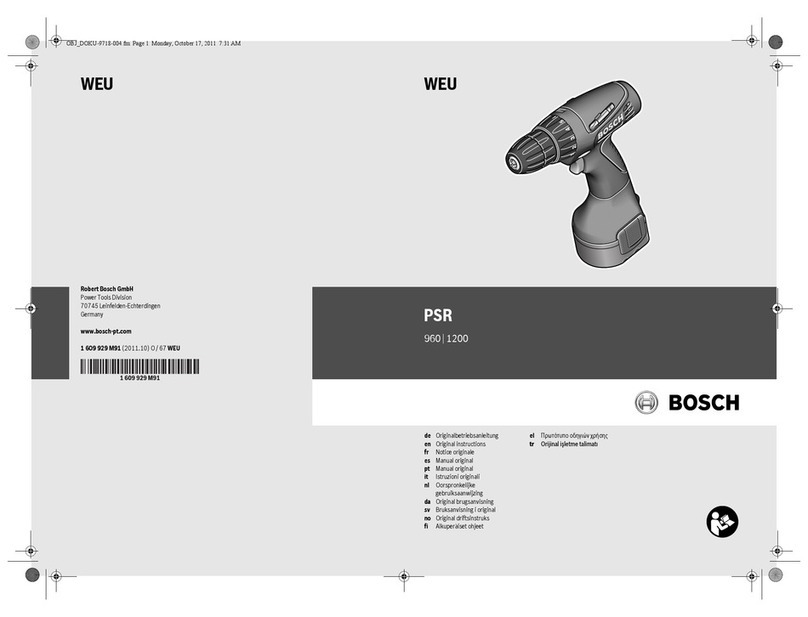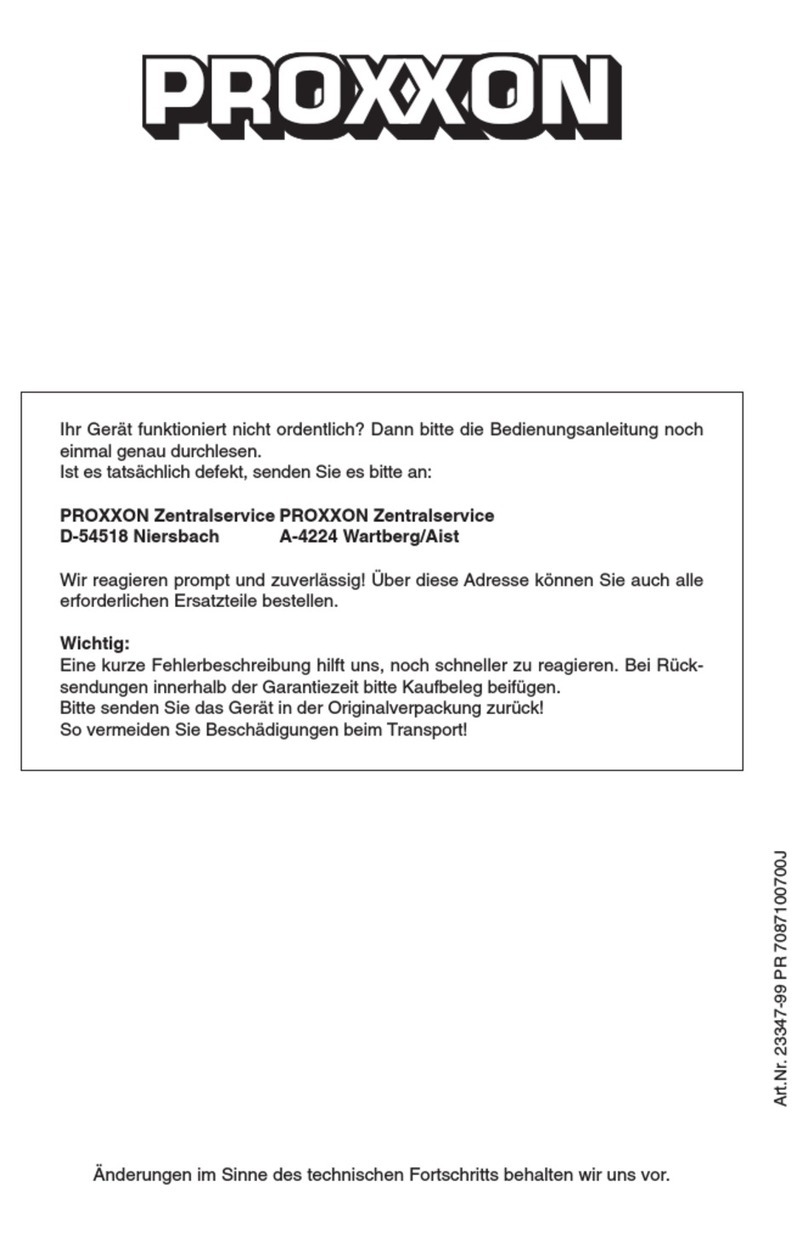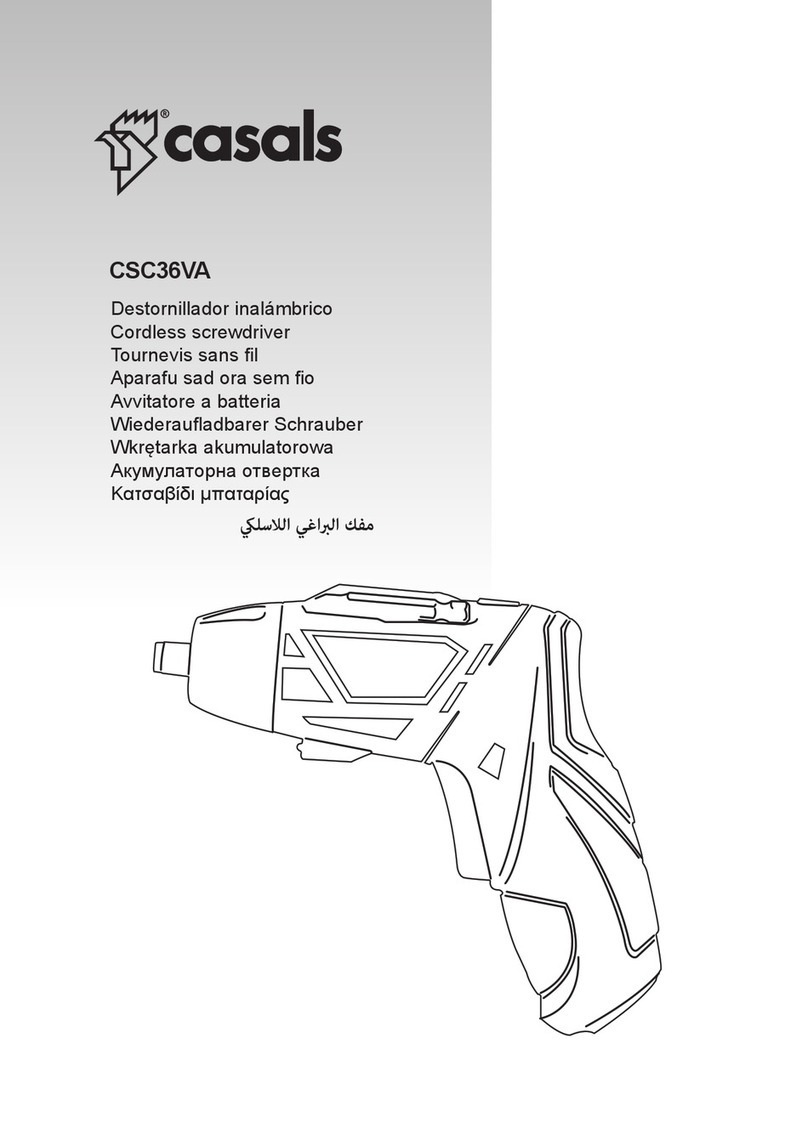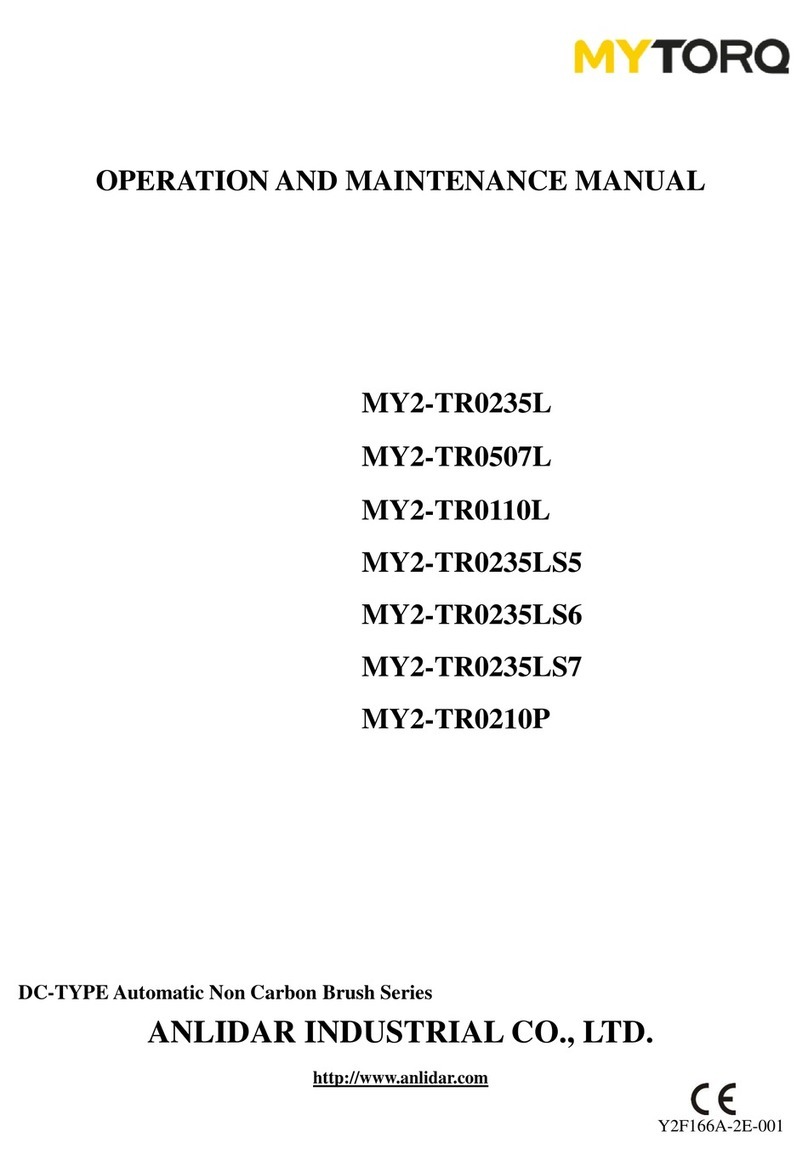Feider Machines FVAC20V-A User manual

ORIGINAL INSTRUCTIONS>EN
CORDLESS IMPACT SCREWDRIVER
FVAC20V-A
USER GUIDE
CAUTION:Read the instructions before using the tool.

CONTENTS
1. WARNING INSTRUCTIONS 3
2. INTENDED USE 6
3. PRODUCT DESCRIPTION 7
4. SPECIFICATIONS 7
5. OPERATION 8
6. MAINTENANCE & CLEANING 10
7. STORAGE 10
8. DISPOSAL 10
9. DECLARATION OF CONFORMITY 11
10. WARRANTY 12
11. PRODUCT FAILURE 13
12. WARRANTY EXCLUSIONS 14

1. WARNING INSTRUCTIONS
1.1 GENERAL POWER TOOL SAFETY INFORMATION
WARNING Read all safety warnings, instructions, illustrations and specifications provided with
this power tool. Failure to follow all instructions listed below may result in electric shock, fire and/or serious
injury. Save all warnings and instructions for future reference.
The term "power tool" in the warnings refers to your mains-operated (corded) power tool or battery-operated
(cordless) power tool.
1) Work area safety
a. Keep work area clean and well lit. Cluttered or dark areas invite accidents.
b. Do not operate power tools in explosive atmospheres, such as in the presence of flammable
liquids, gases or dust. Power tools create sparks which may ignite the dust or fumes.
c. Keep children and bystanders away while operating a power tool. Distractions can cause you
to lose control.
2) Electrical safety
a. Power tool plugs must match the outlet. Never modify the plug in any way. Do not use any
adapter plugs with earthed (grounded) power tools. Unmodified plugs and matching outlets will
reduce risk of electric shock.
b. Avoid body contact with earthed or grounded surfaces, such as pipes, radiators, ranges and
refrigerators. There is an increased risk of electric shock if your body is earthed or grounded.
c. Do not expose power tools to rain or wet conditions. Water entering a power tool will increase
the risk of electric shock.
d. Do not abuse the cord. Never use the cord for carrying, pulling or unplugging the power tool.
Keep cord away from heat, oil, sharp edges or moving parts. Damaged or entangled cords
increase the risk of electric shock.
e. When operating a power tool outdoors, use an extension cord suitable for outdoor use. Use
of a cord suitable for outdoor use reduces the risk of electric shock.
f. If operating a power tool in a damp location is unavoidable, use a residual current device
(RCD) protected supply. Use of an RCD reduces the risk of electric shock.
3) Personal safety
a. Stay alert, watch what you are doing and use common sense when operating a power tool.
Do not use a power tool while you are tired or under the influence of drugs, alcohol or
medication. A moment of inattention while operating power tools may result in serious personal
injury.
b. Use personal protective equipment. Always wear eye protection. Protective equipment such as
a dust mask, non-skid safety shoes, hard hat or hearing protection used for appropriate conditions
will reduce personal injuries.
c. Prevent unintentional starting. Ensure the switch is in the off-position before connecting to
power source and/or battery pack, picking up or carrying the tool. Carrying power tools with
your finger on the switch or energising power tools that have the switch on invites accidents.
d. Remove any adjusting key or wrench before turning the power tool on. A wrench or a key left
attached to a rotating part of the power tool may result in personal injury.
e. Do not overreach. Keep proper footing and balance at all times. This enables better control of
the power tool in unexpected situations.
f. Dress properly. Do not wear loose clothing or jewellery. Keep your hair and clothing away
from moving parts. Loose clothes, jewellery or long hair can be caught in moving parts.
g. If devices are provided for the connection of dust extraction and collection facilities, ensure
these are connected and properly used. Use of dust collection can reduce dust-related hazards.
3

h. Do not let familiarity gained from frequent use of tools allow you to become complacent and
ignore tool safety principles. A careless action can cause severe injury within a fraction of a
second.
4) Power tool use and care
a. Do not force the power tool. Use the correct power tool for your application. The correct
power tool will do the job better and safer at the rate for which it was designed.
b. Do not use the power tool if the switch does not turn it on and off. Any power tool that cannot
be controlled with the switch is dangerous and must be repaired.
c. Disconnect the plug from the power source and/or remove the battery pack, if detachable,
from the power tool before making any adjustments, changing accessories, or storing power
tools. Such preventive safety measures reduce the risk of starting the power tool accidentally.
d. Store idle power tools out of the reach of children and do not allow persons unfamiliar with
the power tool or these instructions to operate the power tool.Power tools are dangerous in
the hands of untrained users.
e. Maintain power tools and accessories. Check for misalignment or binding of moving parts,
breakage of parts and any other condition that may affect the power tool’s operation. If
damaged, have the power tool repaired before use. Many accidents are caused by poorly
maintained power tools.
f. Keep cutting tools sharp and clean. Properly maintained cutting tools with sharp cutting edges
are less likely to bind and are easier to control.
g. Use the power tool, accessories and tool bits etc. in accordance with these instructions,
taking into account the working conditions and the work to be performed. Use of the power
tool for operations different from those intended could result in a hazardous situation.
h. Keep handles and grasping surfaces dry, clean and free from oil and grease. Slippery handles
and grasping surfaces do not allow for safe handling and control of the tool in unexpected
situations.
5) Battery tool use and care
a. Recharge only with the charger specified by the manufacturer. A charger that is suitable for
one type of battery pack may create a risk of fire when used with another battery pack.
b. Use power tools only with specifically designated battery packs. Use of any other battery
packs may create a risk of injury and fire.
c. When battery pack is not in use, keep it away from other metal objects, like paper clips,
coins, keys, nails, screws or other small metal objects, that can make a connection from one
terminal to another. Shorting the battery terminals together may cause burns or a fire.
d. Under abusive conditions, liquid may be ejected from the battery; avoid contact. If contact
accidentally occurs, flush with water. If liquid contacts eyes, additionally seek medical help.
Liquid ejected from the battery may cause irritation or burns.
e. Do not use a battery pack or tool that is damaged or modified. Damaged or modified batteries
may exhibit unpredictable behaviour resulting in fire, explosion or risk of injury.
f. Do not expose a battery pack or tool to fire or excessive temperature. Exposure to fire or
temperature above 130 °C may cause explosion.NOTE The temperature „130 °C“ can be replaced
by the temperature „265 °F“.
g. Follow all charging instructions and do not charge the battery pack or tool outside the
temperature range specified in the instructions. Charging improperly or at temperatures outside
the specified range may damage the battery and increase the risk of fire.
6) Service
a. Have your power tool serviced by a qualified repair person using only identical replacement
parts. This will ensure that the safety of the power tool is maintained.
b. Never service damaged battery packs. Service of battery packs should only be performed by the
manufacturer or authorized service providers.
4

c. Hold the power tool by insulated gripping surfaces, when performing an operation where the
cutting accessory may contact hidden wiring. Cutting accessory contacting a "live" wire may
make exposed metal parts of the power tool "live" and could give the operator an electric shock.
1.2 SAFETY INSTRUCTIONS FOR BATTERIES AND CHARGER
Batteries
Never attempt to open for any reason.
Do not store in locations where the temperature may exceed 40°C (104°F).
Charge only at ambient temperatures between 4°C and 40°C(39.2°F and 104°F).
Charge only using the charger provided with the tool.
Store your batteries in a cool dry place (5°C-20°C/41°F-68°F). Never store batteries in discharged
state.
It is better for Li-ion batteries to discharge and reload them regularly (at least 4 times a year). The
ideal charge for long-term storage of your Li-ion battery is 40% of capacity.
When disposing of batteries, follow the instructions given in the section “Protecting the environment”.
Do not cause short circuits. If connection is made between the positive (+) and negative (-) terminal
directly or via accidental contact with metallic objects, the battery is short circuited and an intense
current will flow causing heat generation which may lead to casing rupture or fire.
Do not heat. If batteries are heated to above 100°C (212°F), sealing and insulating separators and
other polymer components may be damaged resulting in electrolyte leakage and/or internal short
circuiting leading to heat generation causing rupture or file. Moreover do not dispose of the
batteries in fire, explosion and/or intense burning may result.
Under extreme conditions, battery leakage may occur. When you notice liquid on the battery,
proceed as follows:
Carefully wipe the liquid off using a cloth. Avoid skin contact.
In case of skin or eye contact, follow the instructions below:
Immediately rinse with water. Neutralize with a mild acid such as lemon juice or
vinegar.
In case of eye contact, rinse abundantly with clean water for at least 10 minutes.
Consult a physician.
Fire hazard! Avoid short-circuiting the contacts of a detached battery. Do not incinerate
the battery.
Charger
Only use the model of charger recommended. See
the technical data".
5

1.4 SYMBOLS
Conforms to relevant safety standards.
To reduce the risk of injury, the user must read and understand this manual
before using this product.
Wear ear protectors. Exposure to noise can cause hearing loss.
Wear eye protection.
Class II, double isolation(only for charger).
Do not dispose of old appliances with domestic rubbish.
2. INTENDED USE
This cordless impact screwdriver is designed to drill wood or plastic. It is not designed for commercial or
professional use.
NOTE: Please read these user instructions carefully before using this tool and retain for
future consultation!
3. PRODUCT DESCRIPTION
1
2
3
4
5
6
7
6

Fig. 1
1. Drive bit retaining ring
2. Forward / reverse selector
3. Handle
4. Hook
5. Battery platform
6. Variable speed on/off trigger
7. LED work light
4. SPECIFICATIONS
Information
The declared vibration total value has been measured in accordance with a standard test method
and may be used for comparing one tool with another;
The declared vibration total value may also be used in a preliminary assessment of exposure.
Warning
that the vibration emission during actual use of the power tool can differ from the declared total
value depending on the ways in which the tool is used;
Power supply
20 V d.c.
Bit shank size
1/4”(6.35mm hex)
No Load Speed
0-2800/min
Impact rate
0-3000 min-1
Battery type
Recommendation of battery to use:
Model: FBA20U2 or FBA20U4
20V d.c. 2Ah or 4Ah
Charger type
Recommendation of charger to use:
Model: FFC20EU
Input:220-240V~ 50-60Hz, 65W max;
Output: 21V d.c., 2.5A
Torque
150Nm
Acoustic pressure level LpA
LpA =max 67.9 dB(A); Uncertainty: K=3 dB(A)
Acoustic power level LwA
LWA =max 78.9 dB(A); Uncertainty: K=3 dB(A)
aw (Vibration)
<2.5 m/s2, K=1.5m/s2.
7

Need to identify safety measures to protect the operator that are based on an estimation of
exposure in the actual conditions of use (taking account of all parts of the operating cycle such as
the times when the tool is switched off and when it is running idle in addition to the trigger time).
Wear hearing protection.
5. OPERATION
5.1 CHARGING THE BATTERY PACK
NOTE: The battery and charger not delivered in package, you can buy Buider battery platform 1
which used for full range.
1). Take the battery pack out of the equipment. Do this by pressing the side pushlock buttons.
2). Check that your mains voltage is the same as that marked on the rating plate of the battery charger.
Insert the power plug of the charger into the socket outlet. The RED LED will then begin to light.
3). Insert the battery pack into the battery charger .then the red LED on charger will begin to Green flash
light.
4). You will find a label with “Charger indicator” of the LED indicator on the charger.
The battery pack can become a little warm during the charging. This is normal.
If the battery pack fails to charge, check:
13. Voltage at the power socket
14. Whether there is good contact at the charging contacts.
15. Whether the battery pack is warm or not, The battery protection system will not allow the battery to be
charged if the battery temperature is over 40℃after use, allow the battery pack to cool to room
temperature before commencing with the charging.
If the battery pack still fails to charge, send the charging unit and the battery pack to our customer service
center.
To ensure that the battery pack provides long service, you should take care to recharge it promptly. You must
recharge the battery pack when you notice that the power of the cordless vacuum drops. Never allow the
battery pack to become fully discharged. This will cause it to develop a defect.
Battery capacity indicator
Press the switch for the battery capacity indicator . The battery capacity indicator shows the charge status of
the battery using 4 LEDs as following:
All 4 LEDs are lit:
The battery is fully charged.
3 LED(s) are lit:
The battery has approx 75% remaining charge.
2 LED(s) are lit:
The battery has approx 50% remaining charge.
1 LED is lit:
The battery will be empty soon, please recharge the battery.
8

5.2 CHARGER INDICATOR
Indicator status
Explanations and actions
Ready for use
The charger is connected to the mains and is ready for use; there is no battery pack
in the charger.
Charging
The charger is charging the battery pack in charge mode.
Battery pack is full of charge.
Charging is finished and battery pack in the charger.
The temperature of battery is too high or too low, the charger is under protection
status. The charging function can be recovered after the temperature is normal.
Unrecoverable battery malfunction.
5.3 INSERTING AND REMOVING THE BATTERY
WARNING: Before making any adjustments ensure the drill is switchedoff with the direction
of rotation selector in the center position
1. Remove the battery: press the battery release latch in and at the same time pull the battery pack off.
2. To insert the battery, push the battery pack onto the contacts of the tool.
5.4 OPERATION FOR THE IMPACT DRIVER (FIG.3)
a) Insert/remove the socket adaptor.
1. Pull the Driver bit retaining ring forward.
2. Insert or remove the adaptor/bit.
3. Release the drive bit retaining ring, it will return to its normal position.
b) Select the direction of rotation.
c) Turn on the impact driver by depressing the variable speed on/off trigger. Increased pressure on the
trigger will increase the speed of the impact driver.
Fig.3
9

6. MAINTENANCE & CLEANING
WARNING!
Never use solvents such as petrol, alcohol, ammonia water etc. The solvents may damage the plastic parts.
CAUTION! Always remove the battery before cleaning.
6.1 MAINTENANCE
a. The impact driver is designed to operate over a long period of time with a minimum of maintenance. All
maintenance and repair must be performed by an authorised service centre.
b. If the impact driver is not working properly, do not attempt to repair it yourself.
c. Do not disassemble the battery. Replace the battery if it wears out.
6.2 CLEANING
d. Keep the ventilation slots free from dust and dirt.
e. Regularly clean the impact driver with a soft cloth. Preferably after each use.
7. STORAGE
a) Remove the battery from the impact driver when it is not to be used.
b) Store the impact driver, battery and battery charger in a secure, dry place, out of reach of children.
c) Put the impact driver, battery and battery charger in the soft bag provided to protect them against dust.
8. DISPOSAL
Electric power tools, as well as their accessories and packaging, must each be able to follow an appropriate
recycling pathway. Only for the countries of the European Union:
Do not throw away your electrical appliance with the household waste! In accordance with the
European Directive 2012/19/EU on waste electrical and electronic equipment and its
implementation in national laws, power tools that can no longer be used must be separated and
follow an appropriate recycling pathway.
10

9. DECLARATION OF CONFORMITY
EC Declaration of conformity
BUILDER SAS
ZI, 32 rue Aristide Bergès- 31270 Cugnaux-France
Tel : + 33 (0) 5.34.502.502 Fax : + 33 (0) 5.34.502.503
Declares that the machinery designated below :
cordless impact screwdriver
FVAC20V-A
Serial number: 20211003469-20211003968
Complies with the provisions of the Directive «machinery »2006/42/CE and national laws transposing it :
Also complies with the following European directives :
EMC DIRECTIVE 2014/30/UE
RoHS DIRECTIVE 2011/65/UE & (EU)2015/863
Also complies with European standards, with national standards and the following technical provisions:
EN 62841-1: 2015
EN 62841-2-2: 2014
EN55014-1:2017+A11:2020
EN55014-2 :2015
Responsible for the technical file: Mr. Olivier Patriaca
Done at Cugnaux, le 15/09/2021
Philippe Marie/PDG
11

10. WARRANTY
WARRANTY
The manufacturer guarantees the product against defects in material and workmanship for a period of 2
years from the date of the original purchase. The warranty only applies if the product is for household use.
The warranty does not cover breakdowns due to normal wear and tear.
The manufacturer agrees to replace parts identifed as defective by the designated distributor. The
manufacturer does not accept responsibility for the replacement of the machine, in whole or in part , and/or
ensuing damage.
The warranty does not cover breakdowns due to:
• insufcient maintenance.
• abnormal assembly, adjustment or operations of the product.
• parts subject to normal wear and tear.
The warranty does not extend to:
• shipping and packaging costs.
• using the tool for a purpose other than that for which it was designed.
• the use and maintenance of the machine done in a manner not described in the user manual.
Due to our policy of continuous product improvement, we reserve the right to alter or change specifcations
without notice. Consequently, the product may be diferent from the information contained therein, but a
modifcation will be undertaken without notice if it is recognized as an improvement of the preceding
characteristic.
READ THE MANUAL CAREFULLY BEFORE USING THE MACHINE.
When ordering spare parts, please indicate the part number or code, you can fnd this in the spare parts list
in this manual. Keep the purchase receipt; without it, the warranty is invalid. To help you with your product,
we invite you to contact us by phone or via our website:
• +33 (0)9.70.75.30.30
• https://services.swap-europe.com/contact
You must create a "ticket" via the web platform.
• Register or create your account.
• Indicate the reference of the tool.
• Choose the subject of your request.
• Describe your problem.
• Attach these fles: invoice or sales receipt, photo
of the identifcation plate (serial number), photo
of the part you need (for example: pins on the
transformer plug which are broken).
12

11. PRODUCT FAILURE
WHAT TO DO IF MY MACHINE BREAKS DOWN?
the repairer will refuse the machine.
Go to the store with the complete machine and with the receipt or invoice.
the repairer will refuse the machine.
c) Create a SWAP-Europe service ticket on the site: https://services.swap-europe.com When making the
request on SWAP-Europe, you must attach the invoice and the photo of the nameplate (serial number).
d) Contact the repair station to make sure it is available before dropping of the machine.
Go to the repair station with the complete machine packed, accompanied by the purchase invoice and the
station support sheet downloadable after the service request is completed on the SWAP-Europe site
For machines with engine failure from manufacturers BRIGGS & STRATTON, HONDA and RATO, please
refer to the following instructions.
Repairs will be done by approved engine manufacturers of these manufacturers, see their site:
• http://www.briggsandstratton.com/eu/fr
• http://www.honda-engines-eu.com/fr/service-network-page;jsessionid=5EE8456CF39CD572AA2AEEDFD
290CDAE
• https://www.rato-europe.com/it/service-network
Please keep your original packaging to allow for after-sales service returns or pack your machine
with a similar cardboard box of the same dimensions.
For any question concerning our after-sales service you can make a request on our website https://
services.swap-europe.com
Our hotline remains available at +33 (9) 70 75 30 30.
If you bought your product on a website:
a) Empty the fuel tank if your product has one.
b) Make sure that your machine is complete with all accessories supplied, and clean! If this is not the case,
If you bought your product in a store:
a) Empty the fuel tank if your product has one.
b) Make sure that your machine is complete with all accessories supplied, and clean! If this is not the case,
13

12. WARRANTY EXCLUSIONS
THE WARRANTY DOES NOT COVER:
• Start-up and setting up of the product.
• Damage resulting from normal wear and tear of the product.
• Damage resulting from improper use of the product.
• Damage resulting from assembly or start-up not in accordance with the user manual.
• Breakdowns related to carburetion beyond 90 days and fouling of carburetors.
• Periodic and standard maintenance events.
• Actions of modifcation and dismantling that directly void the warranty.
• Products whose original authentication marking (brand, serial number) has been degraded, altered or
withdrawn.
• Replacement of consumables.
• The use of non-original parts.
• Breakage of parts following impacts or projections.
• Accessories breakdowns.
• Defects and their consequences linked to any external cause.
• Loss of components and loss due to insufcient screwing.
• Cutting components and any damage related to the loosening of parts.
• Overload or overheating.
• Poor power supply quality: faulty voltage, voltage error, etc.
• Damages resulting from the deprivation of enjoyment of the product during the time necessary for repairs
and more generally the costs related to the immobilization of the product.
• The costs of a second opinion established by a third party following an estimate by a SWAP-Europe repair
station
• The use of a product which would show a defect or a breakage which was not the subject of an immediate
report and/or repair with the services of SWAP-Europe.
• Deterioration linked to transport and storage*.
• Launchers beyond 90 days.
• Oil, petrol, grease.
• Damages related to the use of non-compliant fuels or lubricants.
* In accordance with transport legislation, damage related to transport must be declared to carriers within 48
hours maximum after observation by registered letter with acknowledgement of receipt.
This document is a supplement to your notice, a non-exhaustive list.
Attention: all orders must be checked in the presence of the delivery person. In case of refusal by the
delivery person, it you must simply refuse the delivery and notify your refusal.
Reminder: the reserves do not exclude the notifcation by registered letter with acknowledgement within 72
hours.
Information:
Thermal devices must be wintered each season (service available on the SWAP-Europe site). Batteries must
be charged before being stored.
14

BUILDER SAS
32, rue Aristide Bergès - ZI 31270 Cugnaux - France
MADE IN PRC
Table of contents
Other Feider Machines Power Screwdriver manuals
